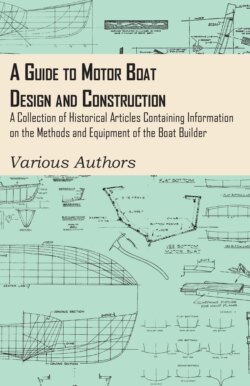Читать книгу A Guide to Motor Boat Design and Construction - A Collection of Historical Articles Containing Information on the Methods and Equipment of the Boat Builder - Various - Страница 4
На сайте Литреса книга снята с продажи.
Boat Building
ОглавлениеBoat building is one of the oldest branches of engineering; concerned with constructing the hulls of boats and, for sailboats, the masts, spars and rigging. It is a specialised occupation that traces its roots into the annals of history, as well as a well-respected trade – and popular hobby. Archaeological evidence indicates that humans arrived on Borneo at least 120,000 years ago, probably by sea from the Asian mainland during an ice age period when the sea was lower and distances between islands shorter. The ancestors of Australian Aborigines and New Guineans also went across the Lombok Strait to Sahul by boat over 50,000 years ago. A ‘boat’ itself, is a watercraft of any size designed to float or plane, to work or travel on water. They come in an enormous variety of shapes, sizes and construction, due to intended purpose, available materials and local traditions.
Most small boats are designed for inland lakes or protected coastal areas, whereas others, such as the ‘whaleboat’ are operated from another ship, in an offshore environment. In naval terms, a boat is a vessel small enough to be carried aboard another vessel (a ship). Yet for reasons of naval tradition, submarines are also usually referred to as ‘boats’ rather than as ‘ships’, regardless of their size. ‘Boat building; was first really advanced by the Vikings, who built ‘longships’; an advancement from traditional clinker-built hulls (a method of boat building where the edges of hull planks overlap). Sometime around the twelfth century, northern European ships began to be built with a straight sternpost enabling the mounting of a rudder – much more durable than a steering oar held over the side. One of the best insights into ship building in the North Sea / Baltic areas of the early medieval period has been found at Sutton Hoo, England, where an entire ship was buried with a chieftain. The ship was 26 metres (85 ft) long and, 4.3 metres (14 ft) wide, built with overlapping oaken planks – holding upwards of thirty men.
A boats construction is usually its defining feature; and the measure of its success or failure at sea. There are several key components which make up the main structure of most boats though. These are, the ‘hull’; the main component that provides buoyancy. The ‘gunnel’; the sides of the boat, offering protection from the water and making it harder to sink. The ‘deck’; the roughly horizontal, but chambered structures spanning the hull of the boat (more commonly found in ships), and above the deck are the ‘superstructures.’ Underneath is the ‘cabin’, which similarly to the ‘superstructure’ will have many constituent parts. Hulls are the most important part of the boat, and the type of hull used is of vital importance; for example, going to sea requires a hull which is more stable than a hull used for sailing rivers (which can be more flat/round).
Until the mid-nineteenth century most boats were constructed using natural materials; primarily wood although reed, bark and animal skins were also used. This changed with the industrial revolution however, when many boats were made with iron or steel frames (now readily available and reasonably inexpensive to construct) – but still planked in wood. Initially, iron was only used in discrete areas in a wooden hull needing greater strength, (e.g. as deck knees, hanging knees, knee riders and the like). Then, in the form of plates riveted together and made watertight, it was used to form the hull itself. Today, boat building is a multi-million pound industry, but can be (and is) done on a much smaller scale too. For those wanting to build their own boat, boat building uses many or the same tools that are common house tools such as hammers, cross cut saws, power drills, benches and vices. For building small boats under 5 metres, some specialized tools are needed such as clamps (cramps) either G clamps or spring clamps. Flat and round surform rasps are also useful tools for shaping wood and ply, as well as drill sets and other power tools.
Although not a ‘traditional’ method, power tools make the job of boat building much easier and are relatively cheap. Circular saws and belt sanders can be invaluable and likewise a steam box can be incredibly useful – excellent for making planks easier to bend although hot wet rags are a messy, but easy substitute. Having said this, one can pay joiners or timber yards to undertake any work that the individual is incapable of doing. One important thing to consider is the space that the amateur boat builder has available; boat building requires enough space, under cover, so that the builder can easily move around the hull during construction. In terms of finishing the boat, water based paint is far easier and cheaper to apply as undercoat, to produce a good smooth finish with a fraction of the time and effort of enamel paints. Harder and slower drying enamel is best for the top coat on the outside of the hull which is subject to a lot of bumps and scraps. Limit varnishing to smaller areas, such as grab rails, hatches, toe rails and trim, unless you have lots of patience and a very dust free environment for varnishing. We hope the reader enjoys this book, and is maybe encouraged to try some boat building of their own!
